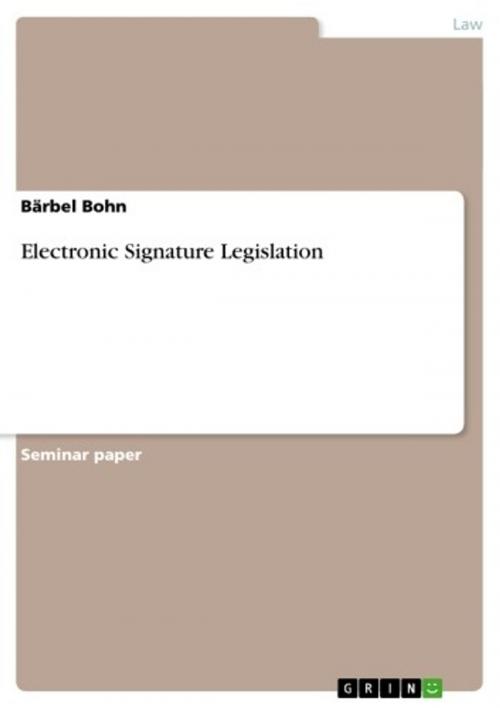| Author: | Bärbel Bohn | ISBN: | 9783638395892 |
| Publisher: | GRIN Publishing | Publication: | July 13, 2005 |
| Imprint: | GRIN Publishing | Language: | English |
| Author: | Bärbel Bohn |
| ISBN: | 9783638395892 |
| Publisher: | GRIN Publishing |
| Publication: | July 13, 2005 |
| Imprint: | GRIN Publishing |
| Language: | English |
Seminar paper from the year 2005 in the subject Law - Media, Multimedia Law, Copyright, grade: 1,3, Bond University Australia, 29 entries in the bibliography, language: English, abstract: As technology develops and the use of computers continues to increase, businesses and people will enter into increasing numbers of contracts based more and more on electronic communications. Electronic commerce though is a broad term that encompasses electronic data interchange (EDI), on-line retailing, and electronic funds transfer (ETF) among other types of transactions. This paper is intended to discuss the need of a more detailed legislation for the Australian Electronic Transaction Act (Cth) 1999 (ETA) in relation to digital signatures. The Key question of this assignment is, if the details of an electronic signature framework should be specified by statute, left to regulation by administrative agencies or simply left to the marketplace. Firstly I will describe the different legislative approaches of jurisdictions around the world. Then I'll have a closer look at the Australian ETA and try to classify them in one of the categories. An analysis of the ETA follows and I will point out the advantages and disadvantages of this Act. Following is a discussion about which legislative approach - explained earlier - is preferable and if there is need for a more detailed legislation for Australia. Furthermore the issues of trust and the rule of third parties in relation to digital signatures are debated. A very important issue in this context involves the allocation of liability and risk of persons using digital signatures, including certification authorities. At the end I recommend the most suitable approach for the Australian Federal Government.
Seminar paper from the year 2005 in the subject Law - Media, Multimedia Law, Copyright, grade: 1,3, Bond University Australia, 29 entries in the bibliography, language: English, abstract: As technology develops and the use of computers continues to increase, businesses and people will enter into increasing numbers of contracts based more and more on electronic communications. Electronic commerce though is a broad term that encompasses electronic data interchange (EDI), on-line retailing, and electronic funds transfer (ETF) among other types of transactions. This paper is intended to discuss the need of a more detailed legislation for the Australian Electronic Transaction Act (Cth) 1999 (ETA) in relation to digital signatures. The Key question of this assignment is, if the details of an electronic signature framework should be specified by statute, left to regulation by administrative agencies or simply left to the marketplace. Firstly I will describe the different legislative approaches of jurisdictions around the world. Then I'll have a closer look at the Australian ETA and try to classify them in one of the categories. An analysis of the ETA follows and I will point out the advantages and disadvantages of this Act. Following is a discussion about which legislative approach - explained earlier - is preferable and if there is need for a more detailed legislation for Australia. Furthermore the issues of trust and the rule of third parties in relation to digital signatures are debated. A very important issue in this context involves the allocation of liability and risk of persons using digital signatures, including certification authorities. At the end I recommend the most suitable approach for the Australian Federal Government.















